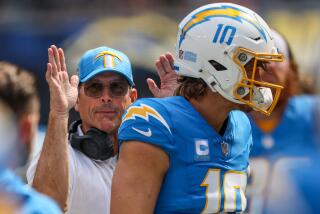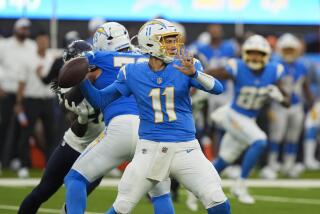THINKING SMALL . . . : From 49ers to 45ers : NFL Roster Reduction Has Caused a Debate
- Share via
SAN DIEGO — It’s difficult to discuss the state of football in 1985 without the name of William Perry coming up.
Even when you least expect it, The Refrigerator is apt to sneak into a conversation from the blind side.
Tex Schramm, president of the Dallas Cowboys, was holding court recently on the problems associated with having only 45 players on the active roster, a decline of four from recent seasons that has some NFL officials in a tizzy.
Schramm mentioned that one of the more outspoken proponents of the smaller roster happens to be Michael McCaskey, president of the Chicago Bears and grandson of George Halas.
“It’s easy for him to think that way, since he’s got a player who can handle three or four positions,” Schramm said. “Having The Refrigerator is almost like having a couple of extra men.”
Along with all the yuks about Perry’s exaggerated size, there are exaggerated claims about the pros and cons of pro football’s svelte new rosters.
The trend in football has long been toward specialization, creating a need for bigger squads. But players cost money, an average salary of $188,000 per man, to be exact, and there’s a creeping fear that some day the NFL will find itself in the same predicament as some other pro sports--with a bunch of teams awash in red ink.
How to save money without damaging the product is the crux of the debate going on among some of the league’s heavy thinkers. The guy with a pair of tickets on the 20-yard line probably would find much of the argument silly, because the NFL is not suddenly going to degenerate to the level of that league that used to play in the spring.
The quality of the game is suffering, argue those who want bigger rosters, a group that includes the Cowboys, Rams, Raiders and Chargers, among others. They say that with just 45 players, you can’t develop young linemen or a third quarterback, and your special teams aren’t as good.
Nonsense, say the guys on the other side, including the Bears, Cincinnati Bengals, Kansas City Chiefs and others. We’ve got to be more economy-minded, they contend. With four fewer players on the payroll, a club could save an average of $750,000 to $1 million a year, and over the next three years, the league as a whole could save $70 to $90 million.
The truth probably is less dramatic. There is no evidence that the game is hurting artistically this year, and it’s too early to conclude that most teams will pocket an extra $1 million a year. Ratings and attendance are up, which bodes well for future negotiations with the television networks--and money is really the key issue when all else is stripped away from the roster debate.
Likewise, the fears of some, that many healthy players would be stashed on the injured-reserve list, do not appear to be grounded in fact. As of midseason, there were 283 players on injured reserve, an increase of 51 over 1984--or an average of about two a team. The number of players on injured reserve is almost identical to the final tally in 1981, the last year the 45-man roster was in effect.
“Over the years, there’s been a lot of concern about the stashing of players, but the number of complaints is way down because of the way we police it now, with neutral doctors checking injured players,” said Jan Van Duser, the NFL’s director of operations.
There is still an occasional abuse.
The New England Patriots got into trouble for an incident that took place last year. They put wide receiver Derwin Williams on injured reserve with a concussion. It turned out that the injury was fictitious, as the player admitted.
“That was an obvious evasion of the player limit so the club could have him available for the following year,” Van Duser said. Accordingly, Commissioner Pete Rozelle penalized the Patriots with the loss of a third-round pick in the 1986 draft.
What the Patriots and others have attempted is not unlike the practice of redshirting players in college football.
Naturally, the coaches of many college teams believe they don’t have enough players, even though their travel squads typically number 60 to 70.
“We have a travel roster of 70 in the Southeastern Conference, and, amazingly, that number can be hard to juggle,” said Alabama’s Ray Perkins, former coach of the New York Giants.
“I would think the NFL could get along with a 45-man roster if they still used the 10- or 15-man taxi squads they used to have.”
Another coach with experience in both college and pro football is the Rams’ John Robinson. He finds the 45-man roster an unpleasant compromise between quality and economy.
“We have to make significant adjustments to keep our kick coverage and return teams viable,” he said. “I don’t think the smaller roster is good, because it makes the game regress. If it stays in effect, though, we’ll all adjust eventually.”
Robinson predicted an increase in the number of long runs on punts and kickoffs in the season’s closing weeks because, with mounting injuries, special teams are manned with either less able or less experienced personnel.
The length of the season--six weeks of training camp followed by 16 regular-season games--makes the reduced roster an absurdity, said Ron Nay, director of scouting for the San Diego Chargers.
“Just stand on the sidelines and listen to the sound of the collisions,” he said. “That will show you how unrealistic it is to ask a team to go 16 games with just 45 players. I mean, the colleges have 60 or more, and they don’t think that’s enough for an 11-game season.”
It’s the hope of some of the lesser endowed teams that they will be able to pick up talented players from the group cut by the NFL’s powers.
But that argument isn’t sound, according to Al LoCasale, executive assistant to the Raiders’ Al Davis.
“We’re pretty sensitive to the things this game requires in order to be a winner and we don’t think a club is going to the Super Bowl on castoffs from the top clubs,” he said.
“We believe what we are selling is football, not the hype that emanates from 410 Park Ave. (the NFL office in New York), and we can see evidence of a decline in special teams play, to give you one area. . . . Look, we’re spending the same amount of money on scouting, but with the elimination of four roster spots, we’re getting less results.”
Some teams, the Cowboys among them, aren’t able to use players who are healthy but still must be carried on injured reserve, according to Schramm.
He said that the Cowboys would like to reactivate guard Brian Baldinger, who suffered a knee injury in the exhibition season. It was feared that surgery would be required, but the injury healed without an operation, and now Baldinger is ready.
“He worked like hell to come back and he might even be starting now, but we can’t bring him back without cutting someone else,” Schramm said. “And we’re not alone. I’ve talked with other teams who have young players losing development time because they’re stuck on injured reserve.”
One of the most outspoken advocates of the smaller squad is Chicago’s McCaskey, who agrees with Schramm that a new mechanism is needed for helping teams hit hard by injuries.
“The 49-man roster is not the answer because it’s too expensive,” he said. “It costs nearly $1 million to carry four extra players, and besides, there’s no guarantee those four will be playing the positions where the injuries strike.”
He suggested the creation of a pool of players from which needy teams could draw. He didn’t provide specifics on the idea.
“The key issue is competitive balance,” McCaskey said, broadening his analysis. “As long as every team reduces by four players, we all have the same resources.
“As far as degrading the quality of special teams, I would suggest that exciting things are happening on kicks this year. The Bears, for example, ran a successful reverse on a punt, which must be the first time in a decade that play has been used. Ideas are as important as skills in many areas of football.”
McCaskey said that many American businesses, ranging from banking to airlines to steel, have learned that they can operate more efficiently with moderate reductions in personnel.
“There’s an economic cycle,” he said. “In flush times, you add to staff. In time comes a natural contraction.”
That contraction is not appealing to the NFL Players Assn., which is more interested in preserving jobs.
“The league is concerned about TV ratings, but they seem willing to sacrifice the quality of play and take a chance on alienating viewers,” said Gene Upshaw, executive director of the NFLPA. “I think fans would be short-changed if a team loses out in a division race because it doesn’t have enough experienced reserves to replace injured starters.”
The debate has been around nearly as long as the NFL. If Halas could be consulted, he would probably favor a return to a roster of 33 players, McCaskey said.
Some of the league’s most bitter arguments have centered on roster size, Van Duser said. “Historically, it’s often been a case of haves vs. have-nots,” he said, “but there are other crosscurrents. There’s the need to develop young players and to have enough fresh players available for practice.”
The NFL enjoyed its highest TV ratings ever in 1981, the last season in which the 45-man roster prevailed. It was increased to 49 in 1982 because of a temporary problem, related to the impending strike, in signing free agents.
There was a lot of wrangling in 1984, brought on by the drafting of college players by the rival USFL. The older league decided to conduct a special supplemental draft of players already in the USFL. The reasoning was that stronger teams would be the only teams that could afford to expend regular draft choices on players they might never be able to sign.
A special arrangement had to be worked out with the players’ union, because of a stipulation that only 336 players can be drafted in a given year. To appease the union, the 49-man roster was retained for 1984.
Economics entered the picture this year.
There were predictions of some clubs losing money as the NFL neared the end of its TV contract. The proponents of the smaller roster, including McCaskey and Paul Brown of the Bengals, were able to exert their influence on a majority of teams.
There’s a standing provision in the collective bargaining agreement that keeps rosters at 45 unless the league acts to increase them to 49 for a given year. A proposal to carry 49 men in 1985 needed 21 votes for approval, but got just 19.
“I wish there was some way to prevent this issue from being a political football each year,” Schramm said. “As it is, we’re trapped. A small minority dictates roster size.
“It’s odd, I think, that we can go to war on a 51% vote of Congress, but it takes a three-quarter vote of owners to change the roster size in the NFL.”
The debate shows no sign of cooling. It may not make much difference to most fans, but to players, it’s everything. And for those athletes who still have a place on the roster, but no job, being stuck on the injured reserve list is no fun at all.
“It’s a helpless, lonely feeling,” said Charger placekicker Rolf Benirschke, who suffered a pulled groin in training camp and hasn’t healed yet. “It’s almost like being a GI who’s been in combat and all of a sudden, he’s no longer on the front line. You’re not sharing the experience anymore.”
Benirschke, who had earlier battled a life-threatening illness and returned to his job, shifted metaphors. “ I’ve learned from having been dealt some tough hands,” he said. “You have to play out the hand you’re holding. You can’t fold, or you’ll never learn what the next hand will be.”
More to Read
Go beyond the scoreboard
Get the latest on L.A.'s teams in the daily Sports Report newsletter.
You may occasionally receive promotional content from the Los Angeles Times.










